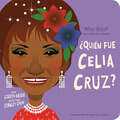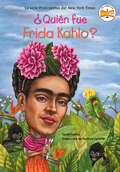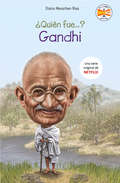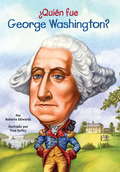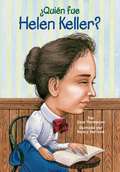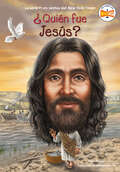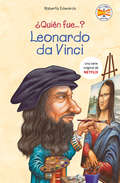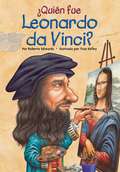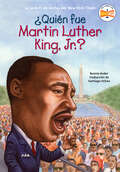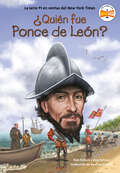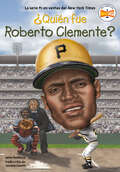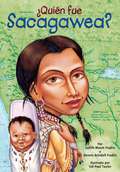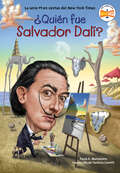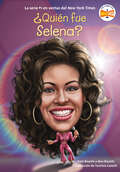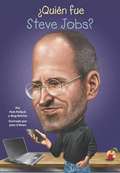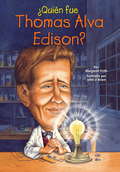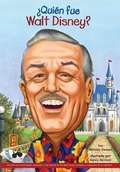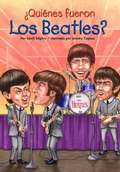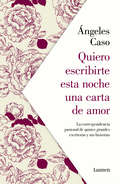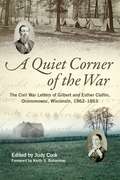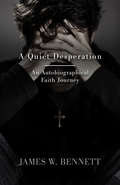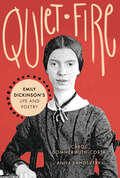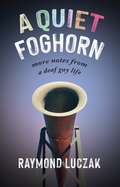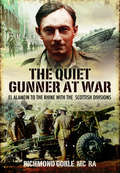- Table View
- List View
¿Quién fue Celia Cruz?: ¿Quién fue? Un libro de cartón (Who Was? Board Books)
by Lisbeth Kaiser Who HQThe first Spanish addition to the Who HQ board book series: a biography of Celia Cruz, created specifically for the preschool audience! ¡La primera adición en español de la serie de libros de cartón Who HQ: una biografía de Celia Cruz, creada específicamente para los niños de preescolar!The #1 New York Times Bestselling Who Was? series expands into the Spanish market, bringing age-appropriate biographies of influential figures to readers ages 2-4.The chronology and themes of Celia Cruz's meaningful life are presented in a masterfully succinct text, with just a few sentences per page. The fresh, stylized illustrations are sure to captivate young readers and adults alike. With a read-aloud biographical summary in the back, this age-appropriate introduction honors and shares the life and songs of one of the most influential performers of our time.WHO WAS? BOARD BOOKS bring inspiring biographies to the youngest readers in an accessible and memorable way. La serie "¿Quién fue?", la más vendida del New York Times, se expande al mercado de habla hispana, llevando biografías de personajes influyentes a lectores de 2 a 4 años. La cronología de la significativa vida de Celia Cruz y los temas de sus canciones, se presentan en un texto magistralmente sucinto, con solo unas pocas frases por página. Las frescas y estilizadas ilustraciones seguramente cautivarán a los jóvenes lectores y a los adultos por igual. Con un resumen biográfico para leer en voz alta en la parte posterior, esta introducción adecuada a la edad, honra y comparte la vida y las canciones de una de las intérpretes más influyentes de nuestro tiempo. ¿QUIÉN FUE? LIBROS DE CARTÓN trae las biografías más inspiradoras a los lectores más jóvenes de una manera accesible y memorable.
¿Quién fue Frida Kahlo? (¿Quién fue?)
by Sarah Fabiny Who HQDescubra más sobre Frida Kahlo, la mujer que pasó a la historia como una de las artistas más emblemáticas del siglo XX. Find out more about Frida Kahlo, the woman who painted herself into history as one of the most iconic female artists of the twentieth century -- now available for Spanish speakers everywhere!Siempre se puede reconocer un cuadro de Kahlo porque ella está en casi todos, con su pelo negro trenzado y sus coloridos trajes mexicanos. Una mujer valiente que estuvo inválida la mayor parte de su vida, se transformó en una obra de arte viva. Tan famosa por sus autorretratos e imágenes inquietantes, así como por su matrimonio con otro famoso artista, Diego Rivera, esta pintora fuerte y valiente se inspiró en la antigua cultura e historia de su amada patria, México. Sus cuadros siguen informando e inspirando a la cultura popular de todo el mundo. You can always recognize a painting by Kahlo because she is in nearly all--with her black braided hair and colorful Mexican outfits. A brave woman who was an invalid most of her life, she transformed herself into a living work of art. As famous for her self-portraits and haunting imagery as she was for her marriage to another famous artist, Diego Rivera, this strong and courageous painter was inspired by the ancient culture and history of her beloved homeland, Mexico. Her paintings continue to inform and inspire popular culture around the world.
¿Quién fue Gandhi?
by Dana Meachen RauUna fantástica serie de biografías ilustradas para conocer a los personajes más destacados de la historia de una forma didáctica y divertida. Mahatma Gandhi es uno de los pensadores más importantes de la historia. Defendió los derechos de su pueblo y se convirtió en un icono mundial de la paz gracias a su lucha constante. Sin embargo, de pequeño fue un mal estudiante que no encontraba su camino. ¡Hasta se casó con solo trece años! Pero hay mucho más... Descúbrelo todo en este libro.
¿Quién fue George Washington? (Quien fue? series)
by Roberta Edwards True Kelley Nancy HarrisonAprenda más sobre el primero presidente de los Estados Unidos, George Washington.
¿Quién fue Helen Keller? (Quien fue? series)
by Gare Thompson Nancy HarrisonA los dos años, Helen Keller quedó sorda y ciega. Ella vivía en un mundo de silencio y la oscuridad. Pero con la ayuda de la maestra Annie Sullivan, Helen aprendió a leer, escribir y hacer muchas cosas extraordinarias. Esta biografía inspiradora es perfecta para los jóvenes lectores. Dibujos en blanco y negro, barras laterales sobre temas relacionados, tales como Louis Braille, una cronología, y una bibliografía mejorará la comprensión de los lectores sobre el tema.
¿Quién fue Jesús? (¿Quién fue?)
by Ellen Morgan Who HQConozca la historia de la vida de Jesús y los orígenes de la fe cristiana en este libro, que es una lectura perfecta para Pascua, Navidad o cualquier otro día del año. Learn about the historic life of Jesus and the origins of the Christian faith in this Spanish entry in the best-selling WHO HQ series!Esta fascinante adición a nuestra serie más vendida ¿Quién fue...? no resuelve cuestiones de teología. En cambio, presenta a los jóvenes lectores una biografía que abarca lo que se conoce históricamente sobre Jesús y sitúa su vida en el contexto de su mundo cuando Jerusalén formaba parte del Imperio Romano. En una narración imparcial y fácil de leer, este título (ilustrado con ochenta dibujos en blanco y negro), también explica los primeros orígenes del cristianismo y cómo se convirtió en una religión importante. This fascinating addition to our best-selling Who Was...? series does not settle questions of theology. Instead, it presents young readers with a biography that covers what is known historically about Jesus and places in his life in the context of his world when Jerusalem was part of the Roman Empire. In an even-handed and easy-to-read narrative, this title--illustrated with eighty black-and-white drawings--also explains the early origins of Christianity and how it became a major religion.
¿Quién fue Leonardo da Vinci?
by Roberta EdwardsUna fantástica serie de biografías ilustradas para conocer a los personajes más destacados de la historia de una forma didáctica y divertida. Leonardo Da Vinci fue uno de los pintores más importantes de la historia, además de un talentoso músico, y un estupendo científico e inventor. Construyó máquinas voladoras, submarinos, ¡e incluso helicópteros! Sin embargo, le costaba mucho terminar las cosas que empezaba. Por eso, hoy en día solamente lo conocemos por sus obras más famosas, pero hay mucho más... Descúbrelo todo en este libro.
¿Quién fue Leonardo da Vinci? (Quien fue? series)
by Roberta Edwards Nancy Harrison True Kelley<P>Leonardo da Vinci fue artista, músico, atleta y científico. <P>Leonardo da Vinci was a gifted painter, talented musician, excellent athlete, and dedicated scientist and inventor, designing flying machines, submarines, and even helicopters. Discover his multi-faceted brilliance with over 100 back-and-white illustrations, in Spanish.
¿Quién fue Martin Luther King, Jr.? (Quien fue? series)
by Bonnie Bader Nancy Harrison Elizabeth Wolf<P>Dr. Martin Luther King, Jr., el famoso líder para derechos humanos habla sobre la injusticia de la raza y la economía. <P>The famous civil rights leader Dr. Martin Luther King Jr. spoke out against racial and economic injustice until his death - from an assassin's bullet - in 1968. This tumultuous time in history comes to life in over 100 black-and-white illustrations that celebrate of this remarkable man.
¿Quién fue Ponce de León? (¿Quién fue?)
by Pam Pollack Meg Belviso Who HQLearn the story of Spanish conquistador Juan Ponce de León and how he shaped the history of both Florida and Puerto Rico during the Age of Exploration. Conoce la historia del conquistador español Juan Ponce de León y cómo influyó en la historia de Florida y Puerto Rico durante la Era de las Exploraciones.In the early 1500s, Ponce de Leon was was one of the most important Spanish military figures in the Caribbean. He made his first voyage across the Atlantic with Christopher Columbus and then, after years of battle with the native Taino, became the first governor of Puerto Rico. Although the story of his search for the Fountain of Youth is entirely fictional, his noteworthy expedition to - and naming of - Florida is one of his greatest legacies. A principios del siglo XVI, Ponce de León era una de las figuras militares españolas más importantes del Caribe. Realizó su primer viaje a través del Atlántico con Cristóbal Colón y luego, tras años de lucha con los nativos taínos, se convirtió en el primer gobernador de Puerto Rico. Aunque la historia de su búsqueda de la Fuente de la Juventud es totalmente ficticia, su notable expedición a Florida (y su nombramiento) es uno de sus mayores legados.
¿Quién fue Roberto Clemente? (¿Quién fue?)
by James Buckley Who HQLa trayectoria relámpago de Roberto Clemente, que pasó de ser un adolescente con talento a un deportista legendario, es una historia para los libros de récords. Descubra cómo un joven de Puerto Rico se convirtió en un MVP, un Todos Estrellas y el primer latinoamericano en el Salón de la Fama del Béisbol. Roberto Clemente's whirlwind journey from talented teen to legendary sportsman is one for the record books. Learn how a young boy from Puerto Rico became an MVP, All-Star, and the first Latin American in the Baseball Hall of Fame in this Spanish edition of the WHO HQ series.Roberto Clemente, el menor de siete hermanos en Puerto Rico, tenía talento para el béisbol. Su increíble habilidad pronto lo llevó a las Grandes Ligas, donde pasó 18 temporadas jugando en el jardín derecho de los Piratas de Pittsburgh. ¿Quién fue Roberto Clemente? cuenta la historia de este extraordinario deportista: 12 veces Todos Estrella, MVP de la Serie Mundial y primer latinoamericano incluido en el Salón de la Fama del Béisbol. Growing up the youngest of seven children in Puerto Rico, Roberto Clemente had a talent for baseball. His incredible skill soon got him drafted into the big leagues where he spent 18 seasons playing right field for the Pittsburgh Pirates. Who Was Roberto Clemente? tells the story of this remarkable athlete: a 12 time All-Star, World Series MVP, and the first Latin American inducted into the Baseball Hall of Fame.
¿Quién fue Sacagawea? (Quien fue? series)
by Dennis Brindell Fradin Judith Bloom Fradin Nancy Harrison Val Paul TaylorAprenda más sobre la guia, Sacagawea.
¿Quién fue Salvador Dalí? (¿Quién fue?)
by Paula K. Manzanero Who HQLearn about the fascinating career of surrealist Salvador Dalí from his early life in Spain through his public life as an internationally famous artist in this exciting addition to the #1 New York Times Best-Selling series.Conoce la fascinante carrera del surrealista Salvador Dalí, desde sus primeros años en España hasta su vida pública como artista de fama internacional, en este nuevo libro de la serie número uno en ventas del New York Times.Most famous for his surrealist painting The Persistence of Memory and its melting clocks, Salvador Dalí combined his dreamlike ideas with his excellent technical skills to become one of the most famous artists of the twentieth century. Beyond painting, Dalí pursued the arts in many other mediums including sculpture, film, fashion, photography, architecture, and more. He was friends with many of his famous contemporaries, including Picasso, Bunuel, Miro, and Duchamp. Learn about the sometimes-shy man with the instantly recognizable upturned mustache in this book for young readers that details the life of one of modern art's most celebrated figures.Más famoso por su pintura surrealista La persistencia de la memoria y sus relojes derretidos, Salvador Dalí combinó sus ideas oníricas con sus excelentes habilidades técnicas para convertirse en uno de los artistas más famosos del siglo XX. Más allá de la pintura, Dalí se dedicó a las artes en muchos otros medios, como la escultura, el cine, la moda, la fotografía, la arquitectura y más. Era amigo de muchos de sus contemporáneos famosos, incluidos Picasso, Buñuel, Miró y Duchamp. Aprende sobre el hombre a veces tímido, con un bigote reconocible al instante, en este libro para lectores jóvenes que detalla la vida de una de las figuras más célebres del arte moderno.
¿Quién fue Selena? (¿Quién fue?)
by Max Bisantz Kate Bisantz Who HQDescubra por qué Selena, la reina de la música tejana, ¡se convirtió en una de las artistas méxico-americanas más célebres del siglo XX! Discover why Selena, the Queen of Tejano music, became one of the most celebrated Mexican-American entertainers of the twentieth century in this Spanish edition of the WHO HQ series!De joven, Selena Quintanilla cantaba en un grupo llamado Selena y Los Dinos con su hermano y su hermana. La familia actuaba en ferias, bodas, fiestas de quince años y en las esquinas de su Texas natal. Selena aprendió a cantar en español y pronto se hizo muy popular entre la comunidad latina, hasta el punto de convertirse en la artista latina más vendida de la década de 1990. Selena estaba lista para llegar a la cumbre del éxito, pero su vida se vio truncada tras ser herida de muerte por la presidenta de su club de fans. Las contribuciones de Selena a la música y a la moda durante su vida la convirtieron en una de las principales estrellas latinas de la década de 1990, y los lectores querrán saber más sobre la mujer que introdujo en el mundo la música tejana. As a young girl, Selena Quintanilla sang in a band called Selena y Los Dinos with her brother and sister. The family performed at fairs, weddings, quinceañeras, and on street corners in their native Texas. Selena learned how to sing in Spanish and soon became hugely popular within the Latino community--so much so that she became the best-selling Latin artist of the 1990s. Selena was poised to be a great success, but her life was cut short after being fatally wounded by the president of her fan club. Selena's contributions to music and fashion during her life made her one of the top Latin musicians in the 1990s, and readers will want to know more about the woman who introduced the world to Tejano music.
¿Quién fue Steve Jobs? (Quien fue? series)
by John O'Brien Meg Belviso Pamela D. Pollack<P>Aprenda más sobre el inventor de Apple, Steve Jobs.
¿Quién fue Thomas Alva Edison? (Quien fue? series)
by Margaret Frith Nancy Harrison John O'Brien<P>Un día en 1882, Thomas Edison cambió la manera que humanos viven con la invención de electricidad. <P>One day in 1882, Thomas Edison flipped a switch that lit up lower Manhattan with incandescent light and changed the way people live ever after. The electric light bulb was only one of thousands of Edison's inventions, illuminated in John O'Brien's wonderful black-and-white illustrations.
¿Quién fue Walt Disney?
by Whitney Stewart Nancy HarrisonAprenda más sobre el inventor de Disney, Walt Disney.
¿Quiénes fueron los Beatles? (Quien fue? series)
by Geoff Edgers Jeremy Tugeau Nancy HarrisonAprenden más sobre los músicos, los Beatles.
Quiero escribirte esta noche una carta de amor: La correspondencia pasional de quince grandes escritoras y sus historias
by Ángeles CasoLa asombrosa correspondencia pasional de quince grandes escritorasy las historias amorosas que las inspiraron,por la ganadora del Premio Planeta. «Quiero escribirte esta noche una carta de amor», escribe Katherine Mansfield al amante que más tarde se convertiría en su marido. A través de sus cartas, inéditas hasta ahora en español -al igual que muchas otras que recoge este libro-, su voz más íntima se une a la de otras grandes escritoras que sintieron la urgencia de revelar lo inconfesable, el poder del deseo, la insoportable incertidumbre, la desesperación, el dolor de una pasión no correspondida o la inmensa felicidad de amar y ser amado. La abadesa Eloísa de Argenteuil, ya en el siglo XII, se enfrenta al Infierno por escuchar a su carne; Simone de Beauvoir se empeña en destruir cualquier rastro burgués en el amor y en la vida; Ninon de Lenclos rechaza todos los tópicos sobre el arrebato amoroso; la romántica George Sand busca morder el amor hasta sangrar; la madre del feminismo, Mary Wollstonecraft, está dispuesta a ceder todas sus libertades -e incluso a acabar con su vida- si no consigue la entrega de su ser adorado; también la brillante y talentosa Charlotte Brontë implora el afecto de un hombre casado y espera la respuesta a sus cartas más que un mendigo un trozo de pan. Mientras María Zambrano vuelca en las cartas a un amor de juventud su anhelo de matrimonio, Marina Tsvietáieva busca en el amor sin límites la fuente de su inspiración poética o Julie de Lespinasse es capaz de amar al mismo tiempo y con igual intensidad a dos hombres, Emilia Pardo Bazán se revela con gran sensualidad y sexualidad escribiendo a Galdós, y lucha por mantener en secreto su relación... Ángeles Caso nos presenta estas cartas reveladoras y fascinantes, y nos cuenta en las biografías de cada autora -una suerte de «micronovelas»- las historias que les dieron origen: un mapa de la sensibilidad femenina a lo largo de la Historia, una inspiración para escribir cartas de amor, y para amar -e incluso para dejar un amor que nos destruye. Un libro para leer, releer y atesorar.
A Quiet Corner of the War
by Gilbert Claflin Esther ClaflinIn 2002, Judy Cook discovered a packet of letters written by her great-great-grandparents, Gilbert and Esther Claflin, during the American Civil War. An unexpected bounty, these letters from 1862-63 offer visceral witness to the war, recounting the trials of a family separated. Gilbert, an articulate and cheerful forty-year-old farmer, was drafted into the Union Army and served in the Thirty-Fourth Wisconsin Infantry garrisoned in western Kentucky along the Mississippi. Esther had married Gilbert when she was fifteen; now a woman with two teenage sons, she ran the family farm near Oconomowoc, Wisconsin, in Gilbert's absence. In his letters, Gilbert writes about food, hygiene, rampant desertions by drafted men, rebel guerrilla raids, and pastimes in the daily life of a soldier. His comments on interactions with Confederate prisoners and ex-slaves before and after the Emancipation Proclamation reveal his personal views on monumental events. Esther shares in her letters the challenges and joys of maintaining the farm, accounts of their boys Elton and Price, concerns about finances and health, and news of their local community and extended family. Esther's experiences provide insight into family, farm, and village life in the wartime North, an often overlooked aspect of Civil War history. Judy Cook has made the letters accessible to a wider audience by providing historical context with notes and appendixes. The volume includes a foreword by Civil War historian Keith S. Bohannon.
A Quiet Desperation
by James W. BennettA Quiet Desperation is the straightforward autobiographical account of one man's disturbing journey through disabling mental illness and into the Community of Faith. This is a book that has provided help for many who have suffered psychiatric disorders, bringing hope without easy answers.
Quiet Fire: Emily Dickinson's Life and Poetry
by Carol Dommermuth-Costa Anna LandsverkWhen Emily Dickinson died at her home in Amherst, Massachusetts, in 1886, she left a locked chest with hand-sewn notebooks and papers filled with nearly 1,800 unpublished poems. Four years later, her first collection was published and became a singular success. Today Dickinson is revered as one of America’s greatest and most original poets. Using primary source materials, including the poet’s own letters and poems, Quiet Fire presents the life and art of Emily Dickinson to a new generation.
The Quiet Flame: Mother Marianne of Molokai
by Eva K. BetzMarianne of Molokai, the lady who did not shun lepers, comes alive in this vividly written fiction for young people.
A Quiet Foghorn: More Notes from a Deaf Gay Life
by Raymond LuczakIn this collection of essays, Raymond Luczak once again offers readers powerful and deeply personal reflections on his experiences as a Deaf gay man. He begins his journey with the printed word where lipreading is not required, and discovers a family of sorts through the writings of Walt Whitman and others; he ventures deeper into the queer community with thoughts on ageism, disability, and radical faeries. Luczak explores the many nuances within the Deaf community and the audist attitudes of hearing people, particularly in the media, and takes a detour into ASL gloss poetry. He speculates on what the Deaf community will look like a century from now and ends with a long bike ride that celebrates the ongoing questions of being a Deaf gay man.
The Quiet Gunner at War: El Alamein to the Rhine with the Scottish Divisions
by Richmond GorleIn 1939 Dick Gorle was already a professional soldier but stationed in India. After the Dunkirk disaster he was recalled and initially involved in training recruits at Plymouth before going north to form the Highland Division Gunners.We hear of the journey to Egypt and thereafter it is intense action at El Alamein under Monty and the long grueling advance to Tripoli. The invasion of Sicily followed and Gorle describes the horrors of war in the mountains and towns while the locals appeared almost oblivious to the momentous events unfolding around them.Called back to attend Staff College, Gorle rejoined the fray in North West Europe as his Regiment, part of the Lowland Division, received thanks and welcome from those liberated, and fierce and deadly resistance from the retreating Germans. His memoir sums up the elation of victory, the closeness of comradeship and the desperate sadness of losses.
